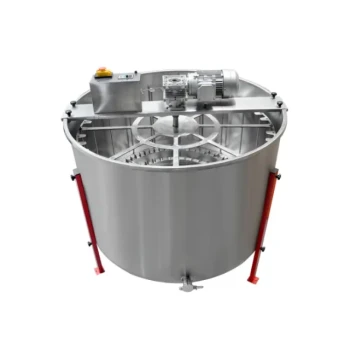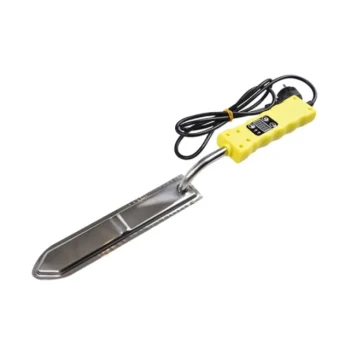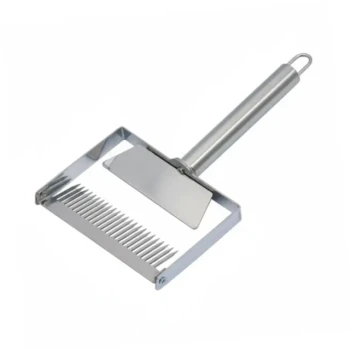As a general rule, you will spin each side of a honey frame for approximately 10 minutes in a tangential extractor. However, this is just a starting point. The optimal time depends on the honey's temperature, the type of extractor you use, and the strength of the comb itself.
The goal of extraction is not just to get the honey out; it's to do so efficiently while preserving the delicate wax comb. A successful extraction saves the bees immense time and energy, as they can immediately reuse the comb instead of rebuilding it from scratch.
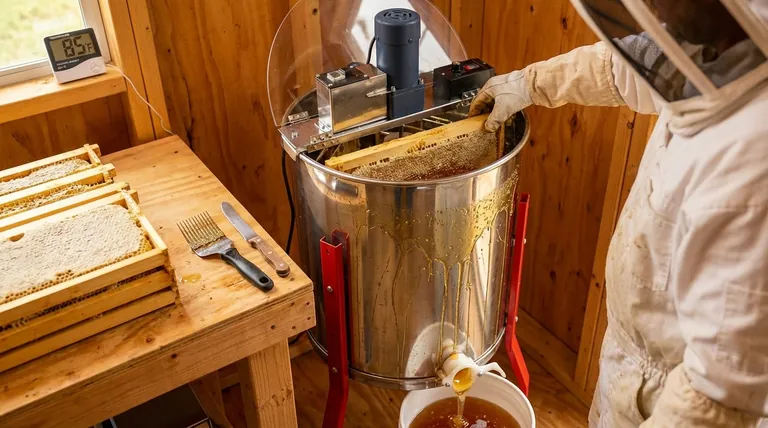
The Principles of Centrifugal Extraction
The entire process of spinning honey relies on centrifugal force. As the extractor spins, it flings the honey outwards from the comb's hexagonal cells, where it drips down the extractor walls and pools at the bottom.
The Critical First Step: Uncapping
Before any spinning occurs, you must uncap the honey. Bees seal each cell of cured honey with a fresh layer of beeswax. This capping must be carefully sliced off with an uncapping knife or scratched open with a fork to allow the honey to exit the cells during extraction.
Why Spin Time Varies
A fixed 10-minute rule doesn't account for key variables that directly impact how easily honey flows.
Honey Viscosity: The thickness of your honey is the single most important factor. Honey extracted from frames in a warm room (80-90°F or 27-32°C) will be much less viscous and flow easily, requiring less spin time. Cold honey is thick and will take significantly longer to extract.
Extractor Speed: The speed, or RPM (revolutions per minute), of your extractor matters immensely. Higher speeds extract honey faster but dramatically increase the risk of damaging the comb. It's a delicate balance.
Comb Age and Strength: Older, darker comb that has been used for multiple seasons is generally stronger and can withstand more force. Freshly drawn-out, light-colored comb is extremely fragile and requires a much gentler and slower extraction process.
Understanding the Trade-offs: Speed vs. Comb Safety
Your primary challenge is to get all the honey out without destroying the comb. Spinning too fast or for too long on one side can have serious consequences.
The Danger of a "Blowout"
A "blowout" occurs when the force of the extraction breaks the wax comb away from its central foundation. This is most common in tangential extractors, which spin one side of the frame at a time.
If you spin the first side at full speed, the weight of the honey still trapped in the second side can create enough outward pressure to shatter the delicate wax structure of the first side. A blown-out comb is ruined and cannot be reused by the bees.
The Two-Stage Method to Prevent Blowouts
To protect your frames, especially in a tangential extractor, you must use a two-stage approach.
- The Partial First Spin: Place the frames in the extractor. Spin them at a low speed for 3-5 minutes. This removes about half the honey from the first side, significantly reducing its weight.
- Flip and Spin Fully: Flip the frames around so the un-spun, heavy side is now facing out. You can now increase the speed and spin for a full 10 minutes, as the partially-emptied inner side provides support.
- Flip and Final Spin: Flip the frames one last time. Spin the original side (which is now mostly empty) at full speed for another 5-10 minutes to remove the remaining honey.
Making the Right Choice for Your Goal
Listen to your equipment and observe the results. The sound of honey hitting the extractor wall will change as the frames empty, and the frames themselves will feel significantly lighter.
- If your primary focus is preserving new, fragile comb: Use a very slow initial speed for the first spin and ramp up speed gradually. It is better to leave a little honey behind than to destroy the comb.
- If your primary focus is efficiency with strong, old comb: You can be more aggressive with your speed after the initial, partial spin, likely sticking to the 10-minute guideline for your main spins.
- If you are working with cold, thick honey: Keep the frames in a heated room for 24 hours before extraction. If you cannot, you will need to increase your spin times, but be cautious about increasing speed too quickly.
Ultimately, experience is the best teacher; each harvest will refine your understanding of the right balance for your specific honey and equipment.
Summary Table:
| Factor | Impact on Spin Time | Recommendation |
|---|---|---|
| Honey Temperature | Cold honey is thick; warm honey flows easily. | Extract in a warm room (80-90°F / 27-32°C). |
| Extractor Type/Speed | Higher RPM extracts faster but risks comb damage. | Start slow, increase speed gradually. |
| Comb Strength | New comb is fragile; old comb is stronger. | Use a gentler, slower spin for new frames. |
| Primary Goal | Comb preservation vs. maximum efficiency. | Prioritize a slow, two-stage spin for delicate comb. |
Achieve perfect, efficient honey extraction every time with the right equipment from HONESTBEE.
Our commercial-grade tangential and radial extractors are engineered for durability and gentle, effective spinning to protect your valuable comb. Whether you're a commercial apiary focused on large-scale honey production or a distributor supplying beekeepers, HONESTBEE's wholesale-focused operations provide the reliable, high-performance equipment you need to maximize your harvest and protect your bees' hard work.
Ready to optimize your extraction process? Contact our team today to discuss your needs and explore our full range of beekeeping supplies.
Visual Guide
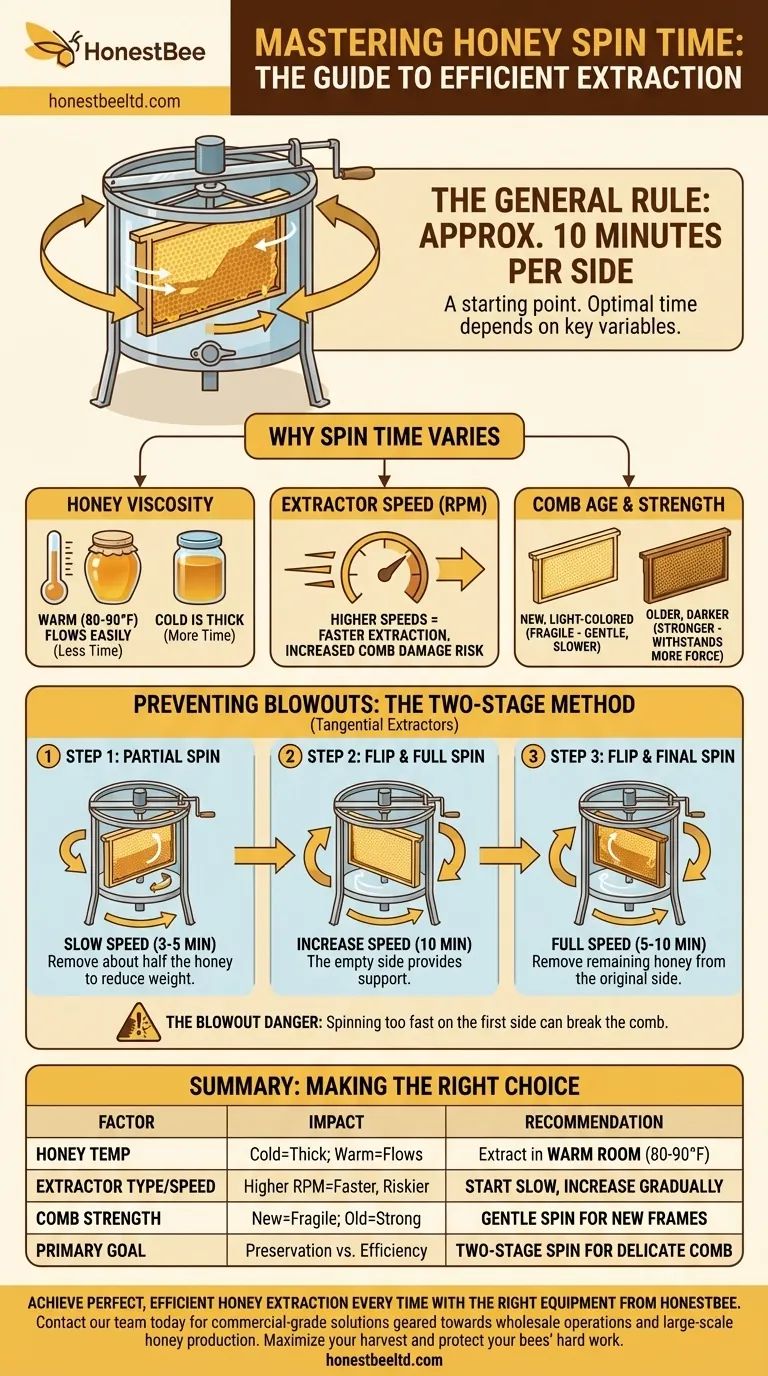
Related Products
- electric honey extractor honey centrifuge 3 frame honey extractor stainless steel honey frame extractor
- 8-Frame Electric Self-Reversing Honey Extractor Spinner for Commercial Honey Extraction Equipment
- Electric 8 Frame Honey Spinner Extractor Equipment for Beekeeping
- 2 Frame Stainless Steel Manual Honey Spinner Extractor for Beekeeping
- 40 Frame Commercial Electric Honey Extractor for Beekeeping
People Also Ask
- What is a honey extractor and why is it beneficial for beekeepers? Boost Hive Health & Harvest Efficiency
- What are the steps for honey extraction using a centrifuge? A Guide to Efficient, Comb-Preserving Harvests
- How long does honey take to extract? A Guide to Streamlining Your Harvest Process
- What are the two main types of honey extractors? Choose Between Tangential and Radial for Your Apiary
- How do automatic honey extractors function? Achieve High-Efficiency Honey Harvesting




